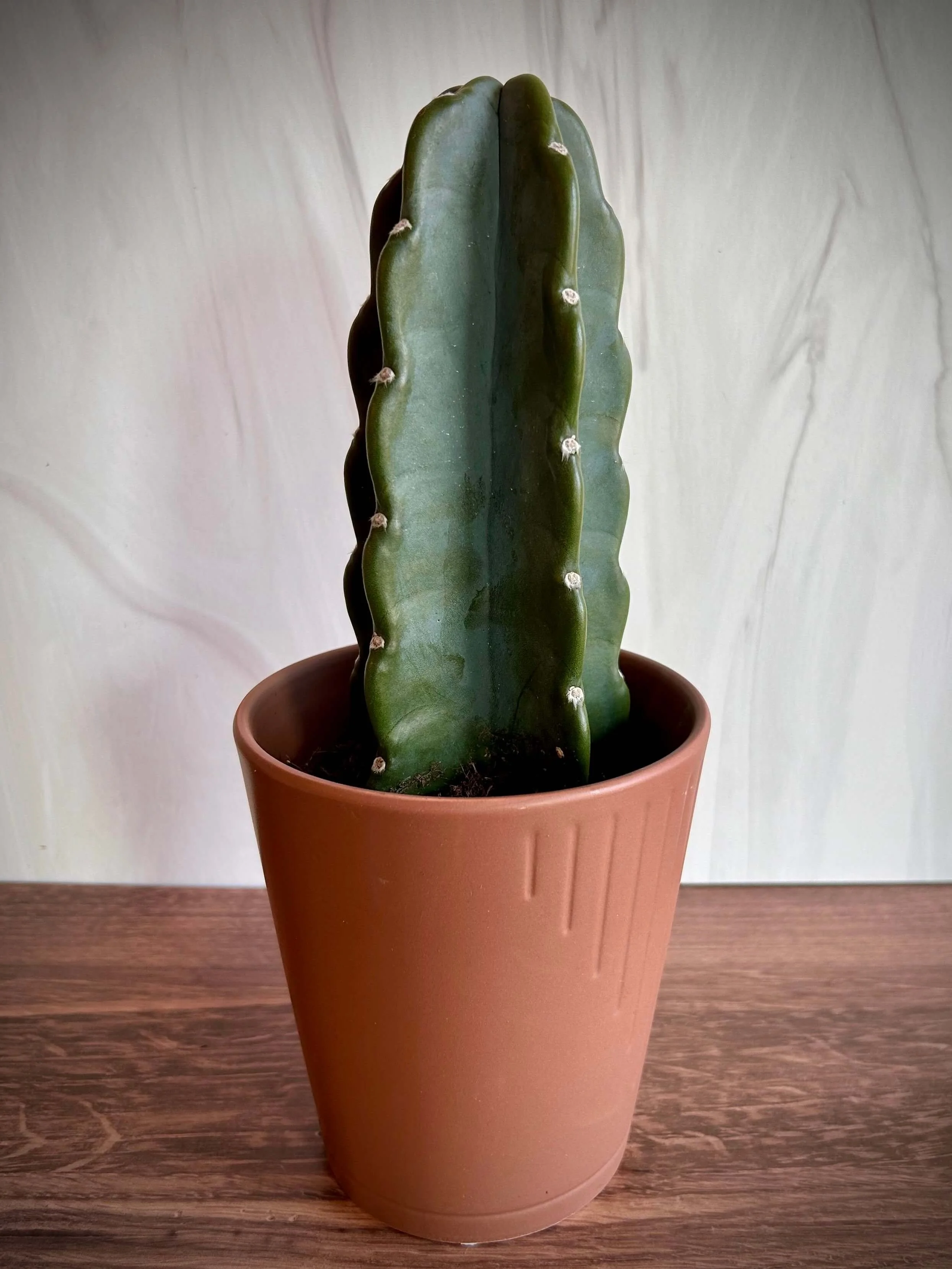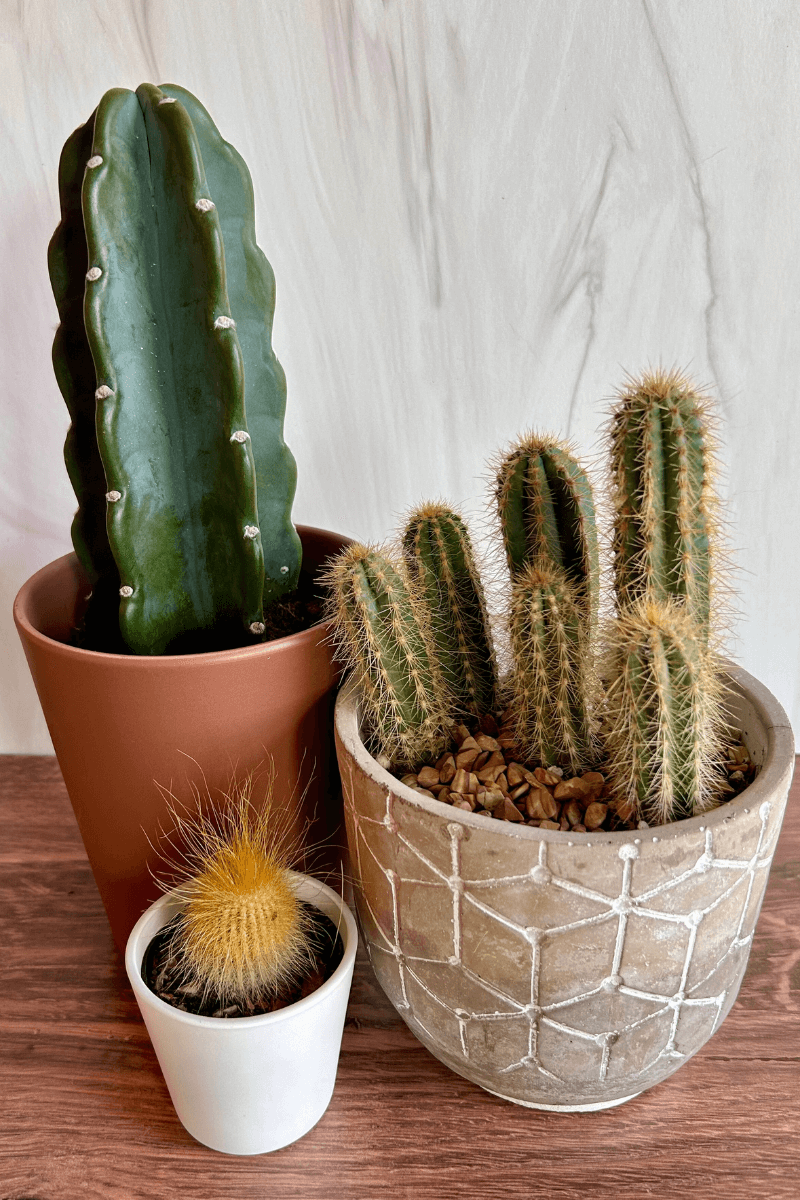The Cuddly Cactus
A Smooth Green Cactus Without Spines or Stickers
This spineless cactus variety is relatively new to the market, and makes a charming addition to your plant collection.
The Cuddly Cactus, also known by its latin name Cereus jamacaru ‘Cuddly Cactus’, is a unique, low-maintenance indoor houseplant. It is a cultivated variety of mandacaru, a species of cactus native to Brazil. This is not the stereotypical prickly, spiny, spiky plant that most people associate with cacti. Instead, the Cuddly Cactus is smooth to the touch, with no needles or spines to prick at you, making it a great choice for homes with pets or children.
The Cuddly Cactus has a bold, chunky, columnar shape and smooth green color. It is easy to grow and looks great on any sunny windowsill, desktop, tabletop, or plant shelf. With no spines or spikes to worry about, you can safely place this plant in any high-traffic area, like a kitchen countertop. Create an appealing contrast of texture, form and color by grouping the Cuddly Cactus alongside other sun-loving indoor cacti.
How Do I Care for a Cuddly Cactus?
A Cuddly Cactus is very easy to care for and does well as an indoor houseplant. It thrives in direct sunlight or bright, indirect light, with a preference for south or west facing windows. Cuddly cactus do not do well in low light conditions.
Water every 2-3 weeks, when the potting soil has completely dried out. Ensure the pot has drainage holes, as the Cuddly Cactus prefers well-draining soil and dislikes having wet roots. Fertilize plants monthly from spring through early fall with a cactus or succulent fertilizer (carefully follow the manufacturer’s instructions).
If your Cuddly Cactus exhibits a mushy stem or brown spots, or if the potting soil emits a foul odor, it is a sign of overwatering. Allow the soil to thoroughly dry out and reduce the frequency of your watering. If you notice wrinkles on your Cuddly Cactus, it’s a sign of underwatering. Water your plant generously until the soil is uniformly moist and excess water begins to drain from the bottom of the pot. Increase the frequency of your watering sessions, aiming for a thorough watering every 2-3 weeks. Most cacti have low-water requirements - not no-water requirements!
If you are unsure of when to water your cactus, consider using a moisture meter. A moisture meter is a handy gardening tool designed to gauge the moisture content in the soil of potted plants or outdoor garden beds. It typically consists of a probe that is inserted into the soil, with a meter that indicates the level of moisture present. This information helps you determine when it's time to water, helping to prevent overwatering or underwatering.
How Do I Repot my Cuddly Cactus?
The Cuddly Cactus has no spines, making repotting a simpler endeavor.
Cacti generally don't need to be repotted very frequently. These plants prefer to be slightly pot-bound, meaning they like their roots to be a bit snug in the pot. Repotting too often can disrupt their root system and stress the plant. As a general rule of thumb, repot your Cuddly Cactus every 2-3 years. This time frame allows you to refresh the plant’s soil and check on the health of the roots. Here are some general guidelines for when to consider repotting your Cuddly Cactus (and since this cactus does not have spines, no heavy gloves are needed - hooray!):
Choose the Right Time:
Spring or early summer is typically the best time to repot most plants, including cacti, as they are entering a period of active growth.
Gather Supplies:
Select a new pot that is slightly larger than the current one and has drainage holes.
Use a well-draining cactus or succulent potting mix.
Water the Cactus:
Water the cactus a day or two before repotting. This helps the soil stick together during the process.
Remove the Cactus from the Pot:
Gently tip the pot on its side and slide the cactus out. If it's stuck, tap the bottom and sides of the pot to loosen the soil.
Inspect the Roots:
Check the roots for any signs of rot or disease. Trim off any dead or rotting roots using clean, sharp scissors or pruning shears.
Prepare the New Pot:
Add a layer of fresh cactus or succulent potting mix to the bottom of the new pot.
Place the Cactus in the New Pot:
Center the cactus in the new pot and add more potting mix around it, making sure the final soil level stays the same as the previous pot. Fill in the sides with more potting mix, pressing it down gently to remove air pockets.
How Big Does a Cuddly Cactus Get?
The Cuddly Cactus is a slow-growing plant, and will reach a maximum height of 15 inches high. It’s a great size for any sunny desktop, tabletop, or counter, and makes a unique Zoom background idea. Providing a Cuddly Cactus with the right balance of water, sunlight, and fertilizer is essential for optimizing growth as well as overall health.
Why Do I Have Black and Brown Spots on My Cuddly Cactus?
Black or brown spots on a Cuddly Cactus can be caused by a variety of issues. Here are some of the most common reasons:
Overwatering:
Cacti are adapted to arid conditions and are susceptible to root rot if overwatered. Excess moisture in the soil can lead to fungal issues, causing black or brown spots. Allow the soil to thoroughly dry out and reduce the frequency of your watering. Consider using a moisture meter to help you determine when it’s time to water.
Fungal or Bacterial Infections:
Pathogens, such as fungi or bacteria, can cause discoloration on Cuddly Cactus tissues. This is often seen as dark brown or black spots, or slimy and crusty lesions. These types of infections can be difficult to stop - the best course of action is to dispose of your plant quickly, before the pathogens spread to the other plants in your home. If you are determined to save the plant, place it under quarantine by sequestering it away from your other plants and beginning a course of treatment with copper fungicide, carefully following the instructions on the label (read more about cactus diseases on the Texas A&M Agrilife Extension website).
Sunburn:
Cacti can get sunburned if they are suddenly exposed to intense sunlight, and these sunburned areas may turn brown or black. This situation can arise when your Cuddly Cactus has spent months in the low-light conditions of a grocery store or big-box retailer. Upon bringing your latest plant discovery home, you eagerly position it on the sunniest windowsill available. However, this transition may be a bit too abrupt for the plant! To remedy this situation, temporarily move the plant to a spot with lower light levels, then gradually reintroduce the plant to bright or direct sun.
Pests:
Insects, such as scale or mealybugs, can damage cactus tissues, leading to discoloration. Check for signs of pests on the plant.
Physical Damage:
Bruising or wounds from physical injury can cause dark spots on the cactus. Be cautious when handling the plant to avoid damage.
As your Cuddly Cactus begins to heal, the black or brown spots will eventually turn into rough, light brown scabs and scars. Cactus scabs and scars are signs of damage or healing from injuries, and typically do not go away. This scarring is purely cosmetic, and is generally not a reason to get rid of the plant. Consider adjusting the placement of your Cuddly Cactus by rotating the scarred area towards the back, to minimize the visibility of the damage.
For a unique Zoom background, create an appealing contrast of texture, form and color by grouping the Cuddly Cactus alongside other sun-loving indoor cacti.
Is Cuddly Cactus (Cereus jamacaru ‘Cuddly Cactus’) Poisonous to Cats and Dogs?
The Cuddly Cactus is non-toxic and not poisonous to cats and dogs, and unlike some other types of cacti that may have spines or irritating substances, a Cuddly Cactus is typically a safer choice for pets. However, it's always a good idea to monitor your pets around plants and consult with a veterinarian if you have specific concerns or if your pet shows any signs of illness after contact with the plant.
Learn more about plants poisonous to dogs and cats in “Which Plants are Toxic to Dogs?” and “Does your Cat Eat your Houseplants?”.



